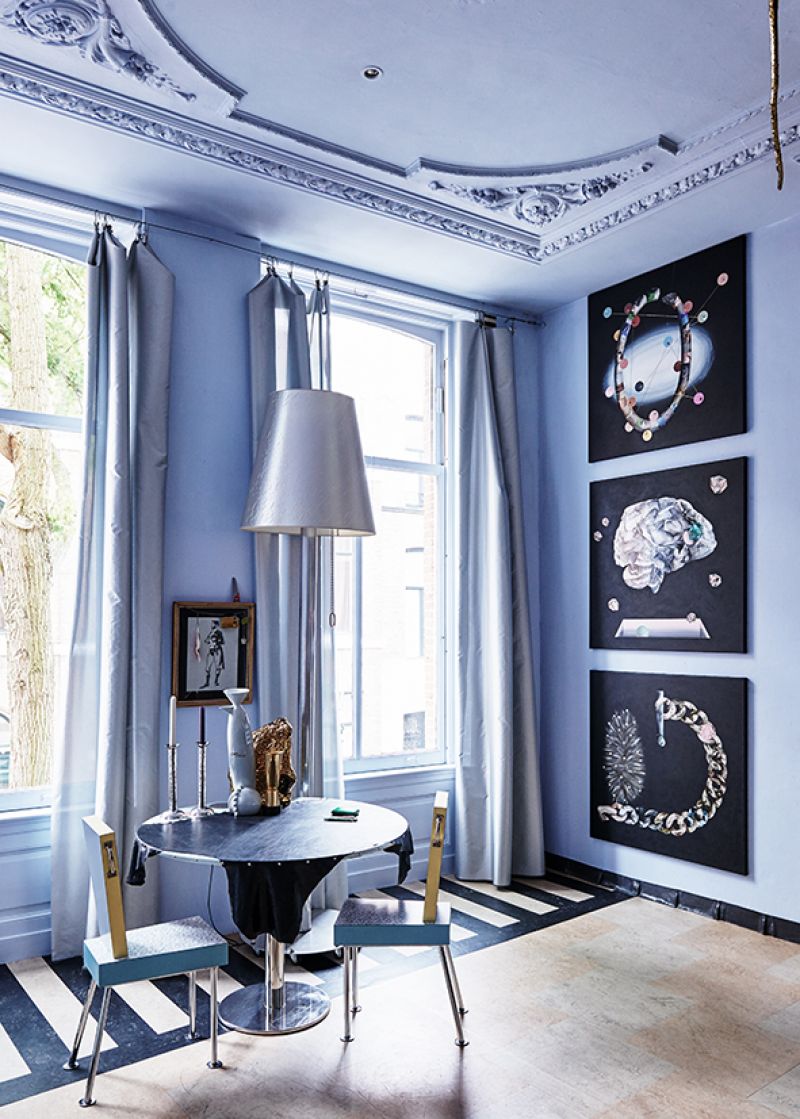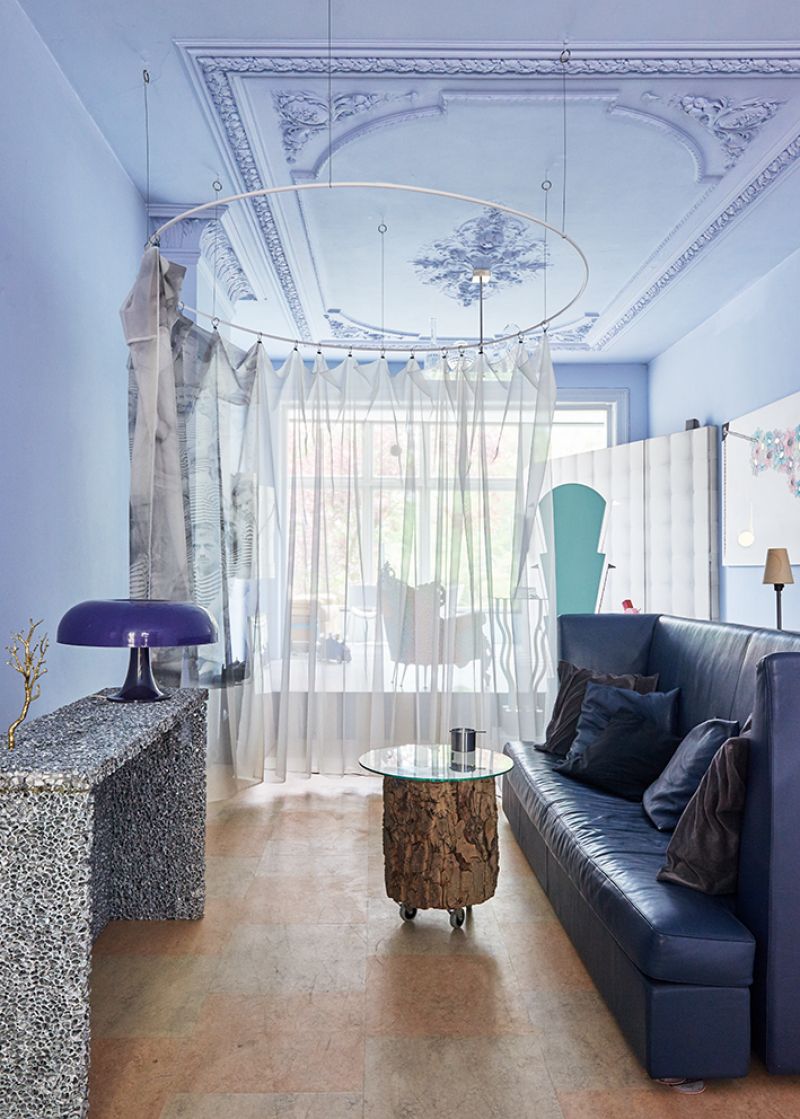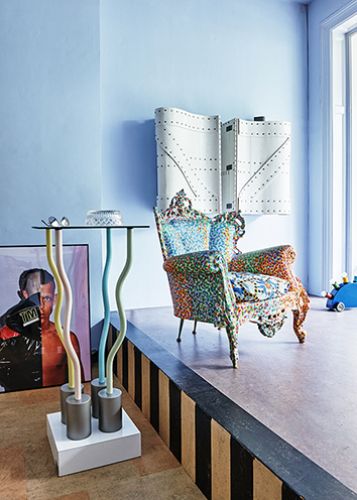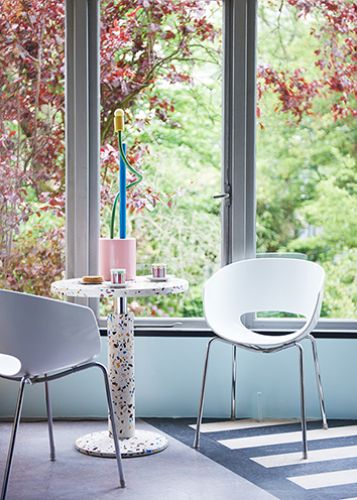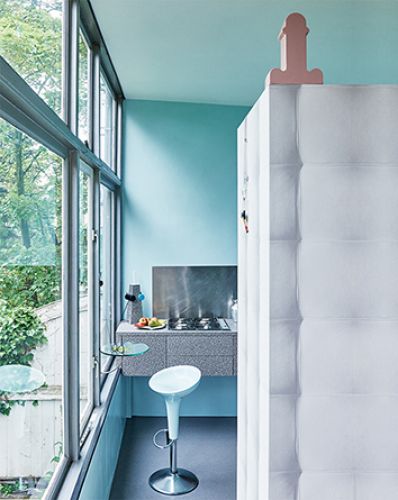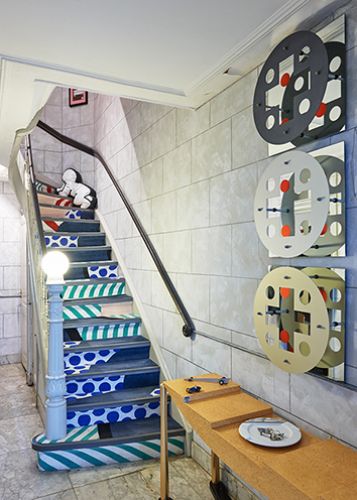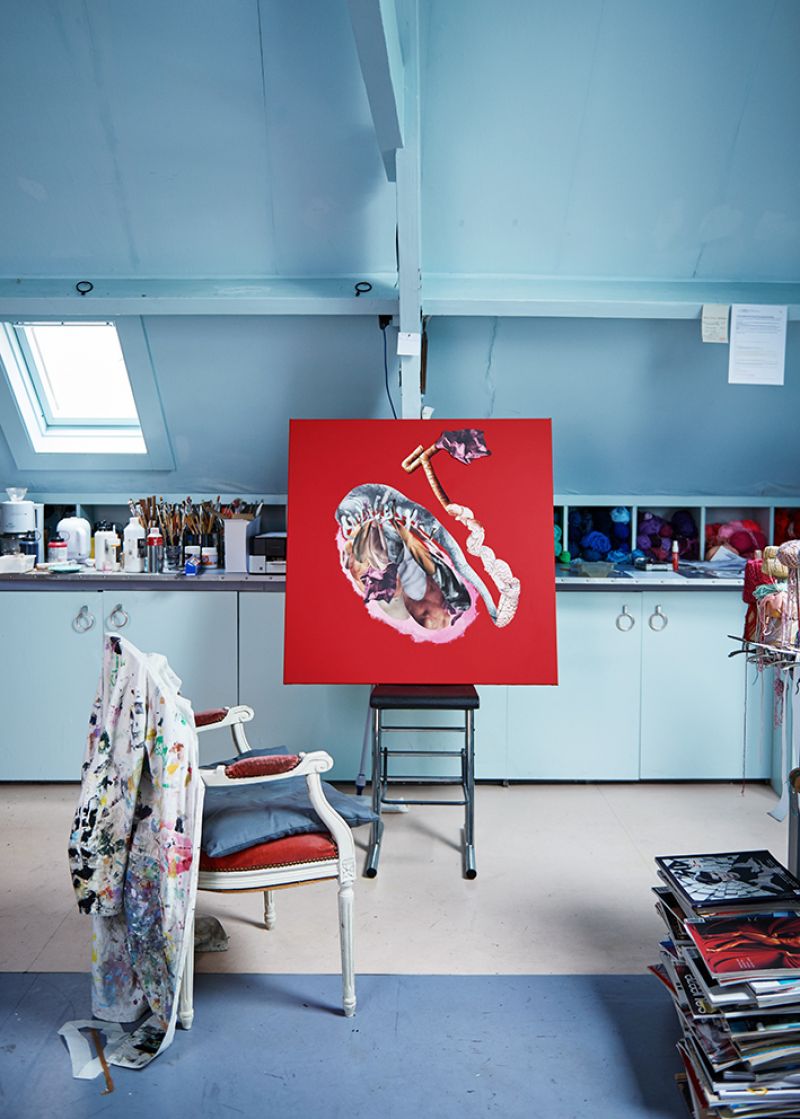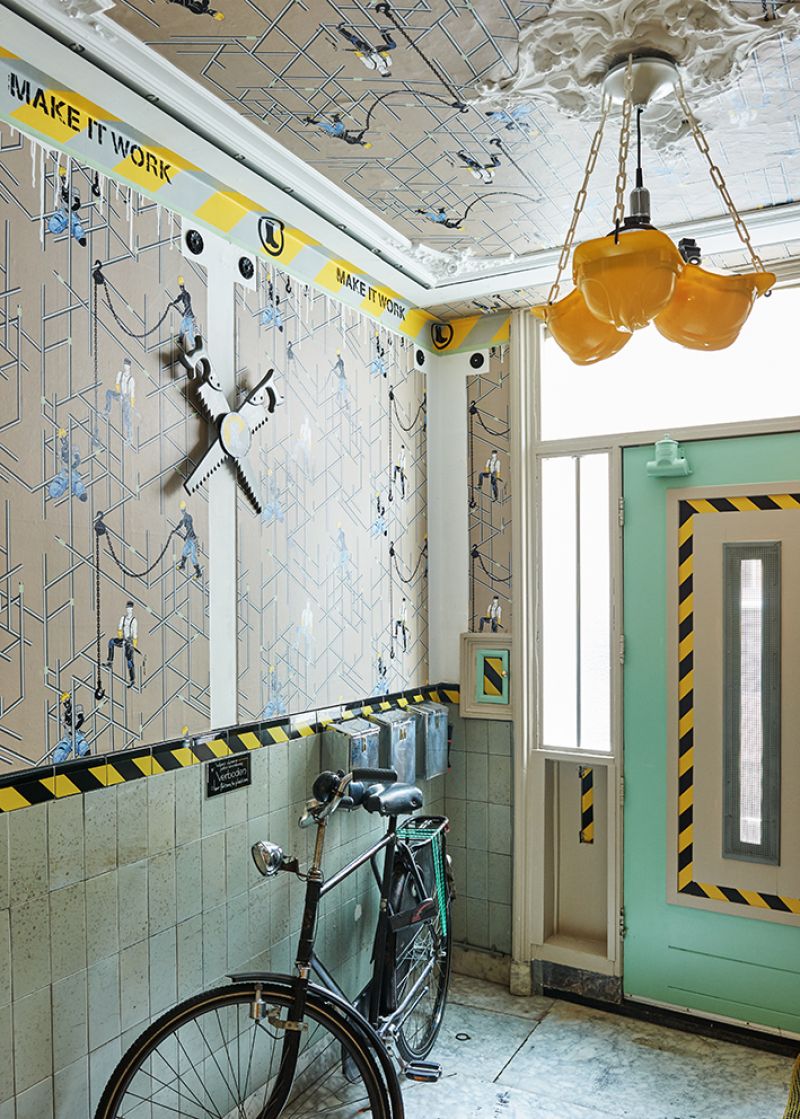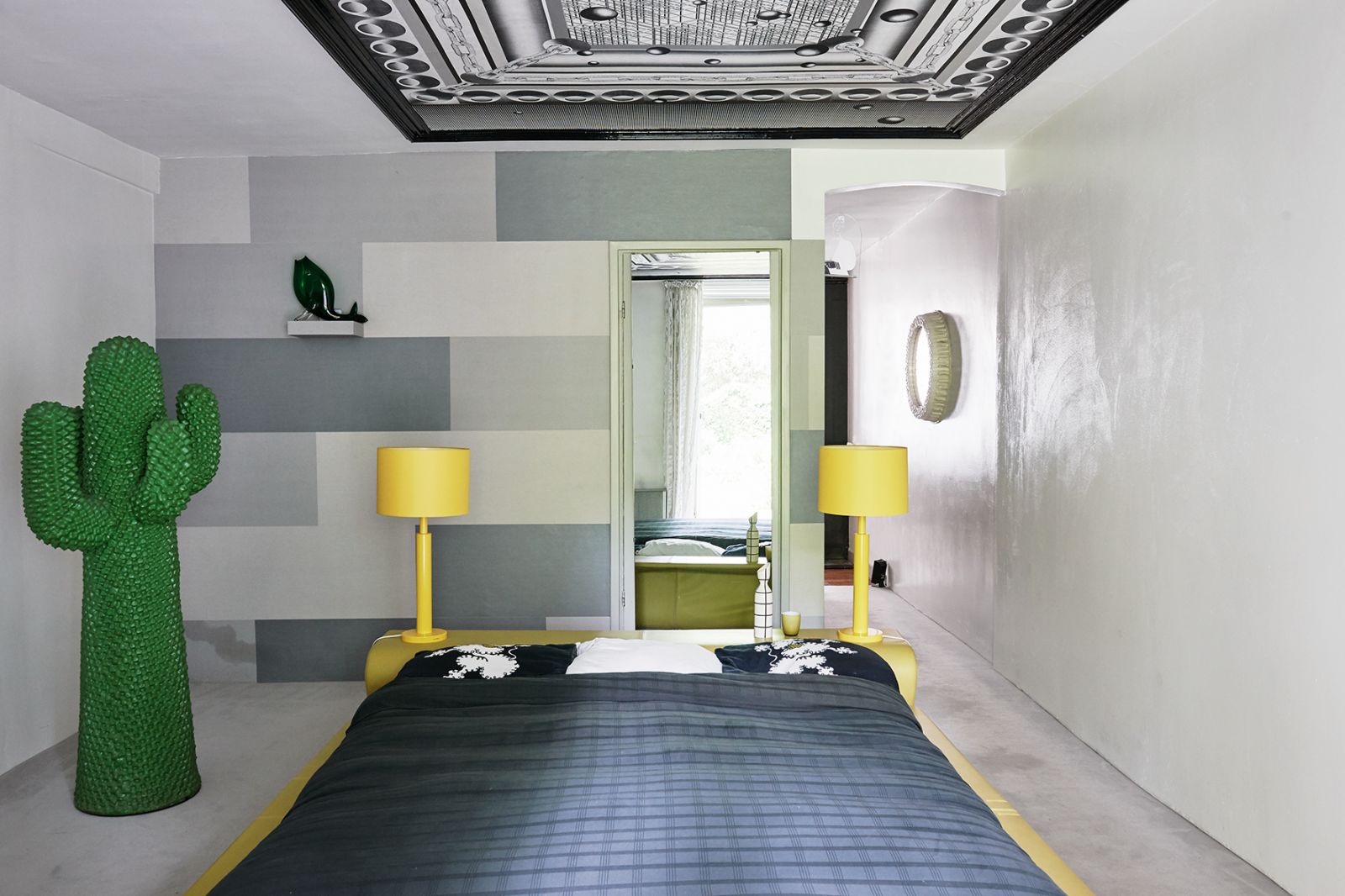‘The totem pole bookcase Casablanca (Ettore Sottsass, 1981) was designed as a freestanding object and hardly has any space for books. I had to save up for that one: it was either the bookcase or a new car. Fortunately, I don’t have a driving licence and the bookcase will last longer.’
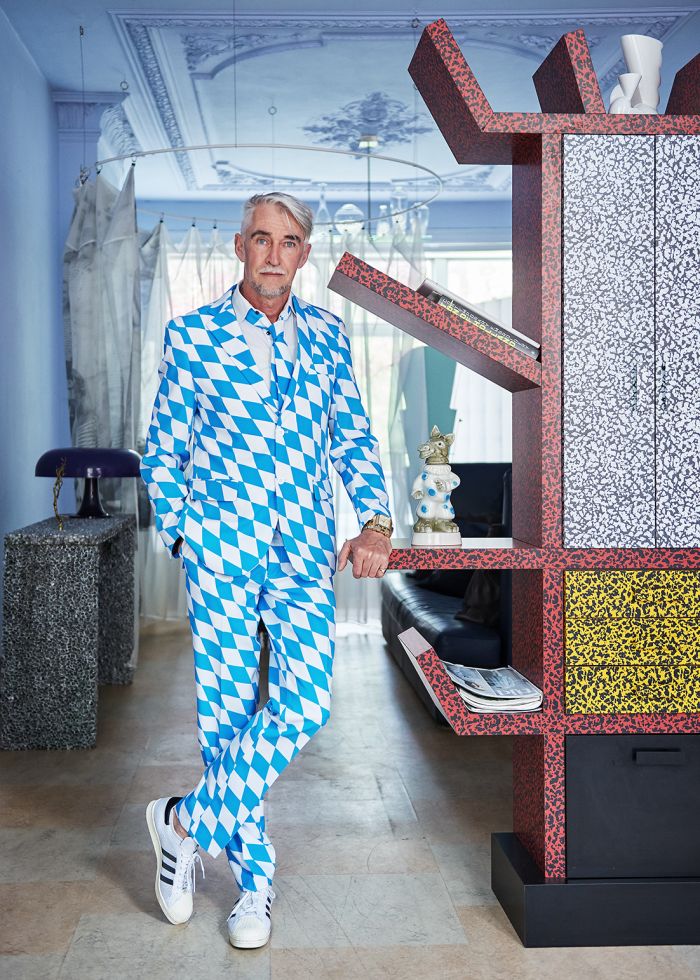
Ton of Holland lives Memphis
‘I’m not that keen on following trends. First something is avant-garde, then it’s mainstream, then it’s outdated and then it’s hip again. Like drip brew coffee or Memphis pieces. It doesn’t mean that much to me, I’ve been drinking drip brew coffee all my life.’
Ton Hoogerwerf, also known as artist Ton of Holland, has lived in his house in The Hague’s Zeeheldenkwartier for 40 years. ‘The building has an incredible history. News of the end of the Second World War was picked up here via radio equipment hidden in the attic for example,’ says Ton. ‘I know exactly who lived here and everything that happened here. I’ve looked it all up.’ When Ton moved into the house in the late 1970s, it was in its original state. ‘Thankfully there were no modular ceilings. There was plywood panelling on the doors but underneath it everything was original. I love living here. It’s a very quiet house in a beautiful, boring street.' The inside of the house is anything but boring though. The stately property is filled with art from the basement to the rafters. His own work hangs cheek by jowl with that of other artists and designers. And it’s being used. No museum arrangements in this house, someone lives here, art and all. ‘I’ve been collecting for years, so the layout changes. The interior is arranged around the Memphis pieces; I’m not likely to move those to the attic. The first piece I bought was an etching by Metten Koornstra, which is still on my studio wall. I was 10 years old at the time and I’ve collected ever since.’ It’s a colourful house; each space has a different atmosphere and is a mix of modern and classic. ‘I absolutely love colour, it wasn’t invented for nothing. Everybody always thinks God rested the Sunday after he created the earth, but on that day, after having coffee, he eventually decided to create colour. He first made everything in black and grey and white, but he decided it was too boring.’
‘The midnight blue leather sofa by Molteni is inspired by a pew, it’s an impressive three metres long. The side table made of aluminium foam is my own design. It looks like it weighs a ton, but I can lift it with one hand. The purple, atom bombinspired lamp is from 1965. The table was made out of a branch of the collapsed walnut tree in my garden (1885- 2015). The net curtains include a 1908 photoprint of sailors. The ring is simple electrical conduit. As a whole, it adds intimacy to the huge space and creates a beautiful diffuse light.’
Every year, he overhauls the space.‘With a house this old, you never stop working, you simply cannot do everything at once. The lilac in the living room will be gone soon, I’m going to repaint it in another colour.’ The only space that is white is the bedroom, where even the walls are bare. ‘In the bedroom, I want peace and quiet. When you’re in bed, you look up and I do want to see something there, hence the illustration on the ceiling. I made it myself; it’s straight from the photocopier
Next to the Mendini chair stands a console table by Ettore Sottsass (1980) from Alchimia’s first Bau.haus 1 collection. The pale green lamp with little silver flags is by Mendini for Nuovo Alchimia (1984). This one is fitted with tiny lights. Museum Boijmans Van Beuningen has one without lights, which immediately makes it an object. Philip Starck designed the cordless chandelier for Baccarat. ‘The crystal vases are fitted with lights and project a special sparkle pattern onto the lilac ceilings.’ The embroidered painting against the wall to the left is a work by Ton. The terrazzo and coloured glass coffee table is by Shiro Kuramata (1983). The lamp is by Michele de Lucchi (1980) for Alchemia's Bau.haus 1-collection and is based on a plant. ‘There are no plants in the house, no soup vegetables, as I call them. The 7.5 metre glass rear façade borders on the garden; that’s where plants belong! The cups and saucers full of nuts and bolts are by Cubic 3 design. The chairs are cheap rip-offs that are very comfortable and manage to survive the surrounding designer frenzy astonishingly well.’In the conservatory, a floating kitchen has been completely covered in laminate by Abet. ‘At the time (1991), the kitchen was quite revolutionary because none of the drawers have handles. Even now, after 25 years, this is still a great kitchen.’ On the worktop are lamp Astor (Thomas Bley, 1982) and serving platter Tomato (Michele de Lucchi, 1985). The bar stool is spray-painted in the same colour as the walls. On top of the kitchen wall stands Ettore Sottsass’s Shiva vase (1973). 'I covered the steps myself, using carpet designed by Roy Lichtenstein. It was hard to stick a knife into it but this looks a lot better, all the steps are different.’ At the top of the stairs is Keith Haring’s Inflatable Baby (1985). Ton drew whitewash blocks on the walls. The Facelift mirrors are by Cubic 3 Design (1992). The golden-legged table is by Hans Hollein for Memphis (1981). The vide-poche is the Lettuce Plate by Ettore Sottsass for Memphis (1985).
interiors over the years
When I think about my interiors over the years, they’ ve always been out of the ordinary. In the 1990s, the whole house was battleship grey; people called it ‘a depressing interior’ and were asking me why I hadn’t chosen mint green and pink. But I’m not all that keen on following trends, I know what I like.’ Ton had the desk in the library made by artist Mirjam Kuitenbrouwer. Elsewhere in the house there’s a cabinet she made. ‘I don’t tell her what to do, I know what she makes and I like it and so I allow her a free hand. I never understand it when people suddenly stop liking something they bought five years ago, what is that? The items haven’t done anything, they haven’t changed. It’s just in your head.’ Ton has been teaching at Delft University of Technology for 31 years. ‘I’m not an engineer, so I’m a stranger in their midst.’ A lot has changed in creative education over the years. ‘My generation, the baby boomers, made all kinds of arrangements for their children and I think that’s not a good thing. My parents left me to figure everything out for myself. Today, I have students that have seen the world at 20, but they’ ve never camped in Appelscha because their parents didn’t think that was cultural enough. Well, people have never had more opportunities than they have today, but a lack of opportunities is much more character-building.’ On occasion, I’ve told students that I felt as if I was talking to an entire H&M department. All those faded hoodies and identical striped T-shirts. I once asked them if they could possibly wear something else the following week. Of course they looked at me dumbfounded; I’m standing there teaching in shorts or in what they think is a funny suit. But come on, they’re the designers of the future, they need to show something of themselves! That’ s difficult of course, when you’re young, but you’re the one who decides whether you are going to be part of the top of the pyramid.’
‘Unlike the order downstairs, the studio is an enthusiastic mess. Painted in a colour called Sky, with big windows on three sides and an amazing height of more than 5 metres. Here, everything goes, everything’s possible and God is happy. ’'Together with Dennis Koot, I designed a wallpaper collection for boys over 18. I covered the entrance with Construction Workers, which is appropriate because in a house that dates from 1887, you’ re always fixing things.’ The collection won the European Design Award in 2012 and is still available (Ten & Don Wallpapers). The wall tiles are original (1930s), the bicycle is from the 1950s, Ton designed the lamp.
the story behind things
When I was at the Academy (Royal Academy The Hague) I wasn’t just taught art for nine years, but art history for nine years as well. So when you look at a work by Le Corbusier, you don’t just see a chair, you see that era, the mentality of those days, the films that were made, music, fashion, the social climate, all of it has influenced the design. I try to teach students to think future-oriented.If you’re going to design a sofa that will be in the shops in five years' time, who are you designing it for? How will we live then? Will it still be called a sofa? All of the influences from other cultures, what do you do with those? What’s the family composition like? How many square metres will we live on? What electronics will we use? You can’t get away with producing yet another Donald Duck sofa.’ He thinks the story behind things is important. This applies to his work as well. ‘After three frozen shoulders I had to start working in a different way, so I went to live in Berlin for a while. My idea was to visit a different party each day for 90 days. That’s not a problem in Berlin. At every party, I drew someone special. They were published in an award-winning book (Es Geht Auch Ohne, Berlin Nachtbuch). I’m currently working on a series about human disease and discomfort, combined with implants and jewellery, all of them things we’d rather not talk about (the series Medical Body Jewels). This was the first time I used photography in combination with abstraction, embroidery and collage. All hand-made, I’m a craftsman. I’ve been asked why I don’t work on the computer, because I make mistakes and the computer doesn’t. But a lot of people prefer hand-made pieces because they carry emotion. Nobody’s perfect. Sometimes I make mistakes on purpose, but I’m still a perfectionist.’
photos jamesstokes.net
This production was published in WOTH No1. This issue is still available in english via Bruil & van der Staaij. Or get a subscription here!
Dutch versions of WOTH can be ordered in our shop and an NL subscription is available here.
